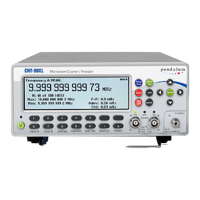that virtually moves the trigger points by half
All time interval functions can be found under
the function menu
Time.
The toggling SLOPE keys (marked with a
under the menus INPUT A/B decide which edge
of the signal will start resp. stop the measure-
ment.
The counter measures the time between a start
condition on input A and a stop condition on
input B.
The counter measures the time between a start
condition on input B and a stop condition on
input A.
Time Interval A to A, B to B
When the same (common) signal source sup-
plies both start and stop trigger events, connect
the signal to either input A or input B.
These functions can be used for measuring
rise and fall times between arbitrary trigger
levels.
CNT-91(R): Time
Interval Error (TIE)
This function can be found under the function
menu Time and is only applicable to clock
signals, not data signals.
TIE measurement uses continuous
time-stamping to observe slow phase shifts
(wander) in nominally stable signals during
extended periods of time. Monitoring distrib-
uted PLL clocks in synchronous data trans-
mission systems is a typical application.
The frequency of the signal to be checked can
be either manually or automatically set. Auto
detects the frequency from the first two sam-
ples. The value is rounded to four digits, e.g.
2.048 MHz and is output on the bus when a
query is sent. It is also displayed as an auxil-
iary parameter in VALUE mode.
TIE is measured as the time interval between
the input signal and the internal or external
timebase clock. These signals are not
phase-locked, so irrespective of the real time
interval value at the start of a measurement, the
result at t = 0 is mathematically nulled. Thus
the graphic representation in STATIS-TICS
mode starts at the origin of coordinates.
Rise/Fall Time A/B
These functions can be found under the func-
tion menu Time.
Rise and fall time can be measured on both in-
put A and input B.
By convention, rise/fall time measurements
are made with the trigger levels set to 10 %
(start) and 90 % (stop) of the maximum pulse
amplitude, see Figure 4-16.
USER MANUAL ● CNT 9x Series ● Rev.22 February 2020
4-16

